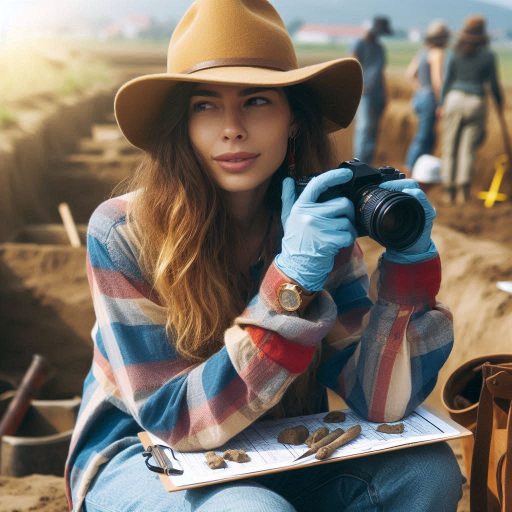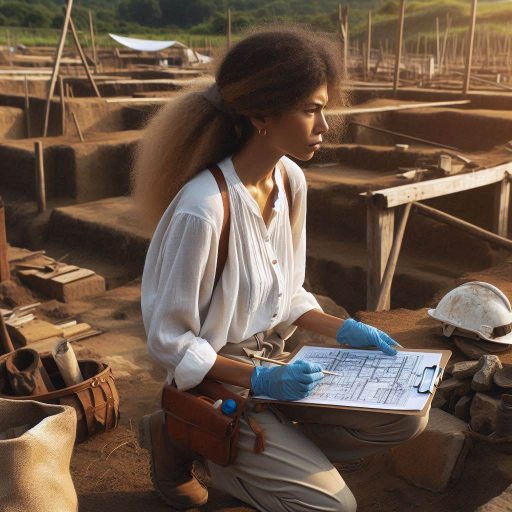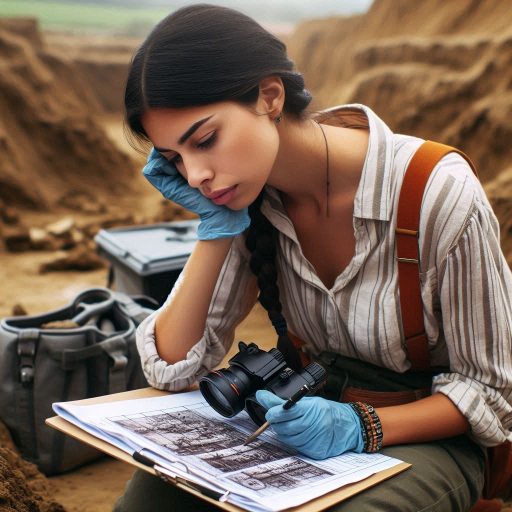Introduction
Archaeology plays a crucial role in uncovering the rich tapestry of American history.
Through the excavation of artifacts, ancient structures, and cultural sites, archaeologists help us understand the diverse narratives that have shaped the nation.
Famous American archaeologists have made groundbreaking discoveries that reveal the lives, customs, and beliefs of indigenous peoples and early settlers.
Their work not only contributes to academic knowledge but also enriches our cultural heritage.
In this post, we will explore the contributions of notable American archaeologists who have left an indelible mark on the field.
Figures like Lewis Binford, known for his innovative methodologies, and Anna O.
Shepard, a pioneer in ceramic studies, have advanced our understanding of prehistoric societies.
Additionally, we will highlight the achievements of archaeologists such as Hiram Bingham, who brought Machu Picchu to international attention, and John Wesley Gilbert, a trailblazer in classical archaeology.
Join us as we delve into their remarkable journeys and celebrate their legacies in the world of archaeology.
Who is Jane Stanford?
Jane Stanford’s Background and Contribution to American Archaeology
Jane Stanford was a remarkable figure in American archaeology.
Born in 1828 in New York City, she came from a wealthy family.
Her early education sparked her interest in natural sciences, especially geology.
In 1876, she married Leland Stanford, a prominent businessman and politician.
Together, they traveled extensively, fostering Jane‘s growing fascination with archaeology.
After her husband‘s death in 1893, Jane became an influential figure at Stanford University.
She used her wealth to support academic research and education.
Her vision led to the establishment of the Stanford University Archaeological Collection.
This initiative significantly contributed to the advancement of archaeology in America.
She believed in the importance of preserving artifacts for future generations.
Her Most Famous Archaeological Discoveries
Jane Stanford‘s most famous archaeological discoveries include significant excavations in the American Southwest.
She was particularly interested in Native American cultures and their artifacts.
Her efforts helped uncover vital information about ancient civilizations, particularly the Ancestral Puebloans.
She supported various archaeological expeditions, providing funding and resources to explore new areas.
One of her notable contributions was her work at the Chaco Canyon site in New Mexico.
This area was a major center of ancient Puebloan culture.
Jane funded research that unearthed numerous artifacts, revealing insights into the lives of these early inhabitants.
The discoveries made during these excavations have been crucial in understanding the region‘s history.
Why She is Considered a Pioneer in the Field
Stanford emphasized the importance of preserving archaeological sites.
She advocated for the protection of these sites from commercial exploitation.
Her efforts led to increased awareness of the need for conservation in archaeology.
Jane Stanford‘s dedication to the field inspired many future archaeologists.
Her pioneering spirit set a precedent for women in archaeology.
At a time when few women were involved in scientific fields, she broke barriers.
Jane Stanford proved that women could make significant contributions to academia and research.
Her legacy continues to inspire new generations of archaeologists.
In recognition of her contributions, many institutions honor her memory today.
Stanford University remains a leading center for archaeological research.
Jane Stanford‘s commitment to archaeology transformed the field, making her a key figure in American history.
Her dedication to discovery and preservation solidified her status as a pioneer in archaeology.
Jane Stanford‘s impact is evident in the ongoing study of ancient cultures.
Her work has left an indelible mark on American archaeology, showcasing the importance of dedicated individuals in the field.
Through her passion and perseverance, she shaped the future of archaeology in America.
Read: Preparing for a Botany PhD: Tips and Advice
The Legacy of John Wesley Powell
John Wesley Powell’s Impact on American Archaeology
John Wesley Powell was a pioneering figure in American archaeology and a remarkable explorer.
Born in 1834 in Mount Morris, New York, Powell became a significant contributor to the understanding of the American West.
His unique background in geology and natural sciences equipped him with the tools needed to study and interpret the landscape.
Powell’s commitment to scientific research led to important advancements in archaeology, particularly concerning Native American cultures.
He advocated for the systematic study of the region’s archaeological sites, emphasizing the need to document and preserve artifacts.
Powell served as the second director of the U.S.
Geological Survey and played a vital role in establishing the discipline of archaeology in America.
He promoted interdisciplinary approaches, combining geology, anthropology, and archaeology.
His efforts laid the groundwork for modern archaeological practices, fostering a deeper appreciation for the historical significance of Native American sites.
His Famous Expeditions and Discoveries
Powell is best known for his groundbreaking expeditions in the late 19th century, particularly his exploration of the Colorado River.
In 1869, he led a historic journey down the river, becoming the first person to navigate its challenging waters through the Grand Canyon.
This expedition provided invaluable geographical knowledge and opened new avenues for archaeological research.
During his expeditions, Powell documented numerous archaeological sites, including cliff dwellings and other remnants of Native American cultures.
He discovered the rich history of the Ancestral Puebloans and their impressive architectural achievements.
His work highlighted the significance of these sites, leading to increased interest in the protection of archaeological resources.
In 1875, Powell published “Report on the Lands of the Arid Region of the United States.
” This influential report emphasized the need for conservation and responsible land management.
His advocacy for preserving archaeological sites resonated with future generations, underscoring the importance of cultural heritage.
How His Work Shaped the Field of Archaeology in America
Powell’s legacy in archaeology extends beyond his discoveries.
He was a champion of scientific research and education, promoting the establishment of the Bureau of Ethnology in 1879.
This institution focused on studying Native American cultures, ensuring that their histories were documented and understood.
Powell’s interdisciplinary approach influenced how archaeologists conduct research today, encouraging collaboration across fields.
His work also helped shape public policy regarding land use and conservation.
Powell advocated for the creation of national parks and monuments to protect archaeological sites.
This vision laid the foundation for future conservation efforts, ensuring that significant cultural heritage sites would be preserved for future generations.
Powell‘s legacy lives on through the ongoing study of Native American archaeology.
His impact is evident in the methodologies employed by archaeologists today.
By emphasizing the importance of rigorous scientific research and cultural preservation, Powell transformed the field of archaeology in America.
His contributions continue to inspire archaeologists and explorers alike, reminding us of the rich history embedded in the American landscape.
Read: Interdisciplinary Research: Botany and Other Sciences
Mary Leakey: A Trailblazer in American Archaeology
Mary Leakey’s Significant Contributions to Archaeology
First, Mary Leakey was a pioneering archaeologist whose work significantly advanced our understanding of human evolution.
Born in 1913 in London, she moved to East Africa with her family, which deeply influenced her career.
Leakey’s passion for archaeology was ignited by her experiences in the field, where she began conducting excavations and research alongside her husband, Louis Leakey.
Together, they focused on the origins of humanity, and Mary became renowned for her meticulous approach to fieldwork.
Mary made substantial contributions to the study of early hominids, particularly through her work at Olduvai Gorge in Tanzania.
This site became one of the most famous archaeological locations in the world due to the significant discoveries made there.
Leakey’s commitment to rigorous excavation techniques and detailed documentation set new standards in the field.
Her work emphasized the importance of context in archaeological findings, which transformed how excavations were conducted.
Her Groundbreaking Discoveries and Their Impact on the Field
One of Mary Leakey’s most groundbreaking discoveries was the Laetoli footprints, found in 1976.
These 3.6-million-year-old footprints provided crucial evidence of bipedalism in early hominids, specifically Australopithecus afarensis.
The footprints demonstrated that these ancient ancestors walked upright, reshaping our understanding of human evolution.
This discovery highlighted the importance of locomotion in the evolutionary timeline and sparked significant interest in the study of early human behavior.
Leakey also discovered numerous hominid fossils, including the skull of Zinjanthropus boisei, which she unearthed in 1959.
This find provided vital insights into the physical characteristics and adaptations of early human ancestors.
Her discoveries significantly impacted the field of paleoanthropology, influencing research methodologies and theoretical frameworks.
Furthermore, Leakey’s work at Olduvai Gorge helped to establish the site as a key location for understanding human evolution.
She and her team meticulously excavated and analyzed the layers of sediment, providing a rich tapestry of evidence that illustrated the changing environment and its influence on early hominids.
This systematic approach to excavation has become a model for archaeologists worldwide.
Why She is Revered as a Trailblazer in American Archaeology
Mary Leakey is revered as a trailblazer in American archaeology for several reasons.
First, she broke gender barriers in a male-dominated field, proving that women could excel as archaeologists and scientists.
Her pioneering spirit and determination inspired countless female archaeologists to pursue careers in the field.
She actively advocated for women’s involvement in science, emphasizing the need for diverse perspectives in research.
Her contributions to the understanding of human evolution have had a lasting impact on archaeology and anthropology.
Leakey’s findings have shaped our knowledge of the origins of humanity and continue to influence contemporary research.
Her dedication to scientific rigor and ethical excavation practices has set a standard for future generations of archaeologists.
Moreover, Leakey‘s ability to communicate complex scientific ideas to the public has made her a beloved figure in the field.
She authored numerous publications and participated in documentaries, effectively bridging the gap between academia and popular science.
Her work has inspired curiosity about human origins, encouraging people to engage with archaeology and its implications.
In recognition of her contributions, Mary Leakey received numerous awards and honors throughout her life.
Her legacy endures through the ongoing research conducted in the field, as her discoveries continue to inform our understanding of human history.
Mary Leakey remains a revered figure in archaeology, symbolizing the spirit of discovery and perseverance in the pursuit of knowledge.
Read: Women in Botany: Celebrating Pioneers and Leaders

The Influence of Lewis Henry Morgan
Lewis Henry Morgan’s Pioneering Work in American Archaeology
Lewis Henry Morgan was a prominent figure in American archaeology and anthropology during the 19th century.
Born in 1818 in Aurora, New York, he initially trained as a lawyer but became fascinated with the study of Native American cultures.
His pioneering work focused on understanding social structures and kinship among Indigenous peoples, particularly the Iroquois, with whom he developed close relationships.
Morgan’s interest in these cultures led him to conduct extensive fieldwork, where he meticulously documented their social customs, governance, and practices.
His groundbreaking ethnographic studies laid the foundation for modern anthropology, emphasizing the importance of participant observation.
Morgan‘s work was notable for its respect and admiration for Native American societies, challenging the prevailing Eurocentric views of the time.
His Theories and Methodologies That Revolutionized the Field
Morgan’s theories and methodologies significantly revolutionized the study of archaeology and anthropology.
One of his most influential concepts was the idea of “cultural evolution,” which posited that human societies progress through stages of development.
He categorized these stages as savagery, barbarism, and civilization.
This framework provided a new lens through which to view the cultural practices of Indigenous peoples, although it has since been critiqued for its oversimplification.
Morgan also introduced the concept of “kinship,” emphasizing the significance of family relationships in understanding social structures.
His detailed analysis of Iroquois kinship practices led to the development of kinship charts, which have become essential tools in anthropology.
By focusing on social organization, Morgan shifted the field’s attention from material culture to the underlying social dynamics that shape human behavior.
Additionally, Morgan’s methodological approach combined rigorous fieldwork with comparative analysis.
He sought to understand cultures within their historical contexts and emphasized the importance of long-term observations.
His work set a precedent for future ethnographers, encouraging them to immerse themselves in the communities they studied.
The Lasting Impact of His Research on the Study of American History
The lasting impact of Lewis Henry Morgan’s research on the study of American history is profound.
His work has been instrumental in shaping our understanding of Indigenous cultures and their contributions to American society.
By documenting the complexities of Native American life, Morgan helped challenge stereotypes and fostered greater appreciation for these cultures.
Morgan’s theories on kinship and social organization have influenced various disciplines beyond archaeology, including sociology and cultural anthropology.
His emphasis on the importance of social structures continues to inform contemporary research, highlighting the need to consider cultural context in historical studies.
Furthermore, Morgan’s work laid the groundwork for future scholars to explore the intersections of culture, history, and anthropology.
His insights prompted a reevaluation of how historians approach the study of Indigenous peoples, encouraging a more nuanced understanding of their histories and experiences.
In recognition of his contributions, Morgan is often regarded as one of the founding figures of American anthropology.
His influence extends to modern discussions of cultural relativism, emphasizing the need to appreciate diverse perspectives in historical narratives.
In summary, Lewis Henry Morgan’s pioneering work in American archaeology revolutionized the field through his innovative theories and methodologies.
His lasting impact on the study of American history and Indigenous cultures continues to resonate, reminding us of the complexities and richness of human societies.
Morgan‘s legacy endures as a testament to the importance of understanding cultural diversity and its role in shaping our collective history.
Read: How Climate Change Is Impacting Plant Research
Explore Further: Astronomy Career Paths: Jobs Beyond Academia
Sarah Parcak: Revolutionizing Archaeology with Technology
Sarah Parcak’s Innovative Use of Technology in Archaeology
First, Sarah Parcak is a trailblazer in archaeology, known for her innovative application of technology in the field.
Born in 1971, she became fascinated with ancient civilizations and their artifacts from an early age.
Parcak’s academic journey led her to earn a Ph.D. in anthropology, where she began exploring the intersection of archaeology and technology.
Her work has focused on harnessing satellite imagery and remote sensing to uncover hidden archaeological sites.
By integrating these advanced technologies, she has transformed how archaeologists conduct research and make discoveries.
Parcak’s pioneering approach emphasizes the importance of data analysis in archaeology.
She advocates for using technology to survey large areas quickly, allowing researchers to locate sites that traditional methods might overlook.
This innovative perspective has enabled archaeologists to access previously inaccessible regions, significantly expanding the scope of archaeological exploration.
Her Groundbreaking Discoveries Using Satellite Imagery
One of Parcak’s most groundbreaking achievements is her use of satellite imagery to identify archaeological sites in Egypt.
In 2009, she led a team that utilized high-resolution satellite images to detect ancient settlements and structures buried beneath the desert sands.
Their work resulted in the discovery of over 1,000 potential sites, including pyramids and temples, which had remained hidden for centuries.
Parcak‘s findings at Tanis, an ancient Egyptian city, exemplify her impactful work.
By analyzing satellite data, she identified a vast network of ancient roads and structures that had previously eluded archaeologists.
This discovery not only shed light on the city’s layout but also provided insights into its historical significance.
The ability to visualize these sites from space has opened new avenues for research, leading to a resurgence of interest in the archaeological study of Egypt.
Additionally, Parcak‘s use of satellite imagery has extended to various other regions, including Peru and Iraq.
Her research has uncovered ancient agricultural systems and potential sites of lost cities, demonstrating the versatility of this technology in different contexts.
Transform Your Career Today
Unlock a personalized career strategy that drives real results. Get tailored advice and a roadmap designed just for you.
Start NowHow Her Work Has Changed the Way Archaeologists Approach Research
Sarah Parcak’s innovative work has profoundly changed how archaeologists approach research and site exploration.
Her use of satellite imagery has revolutionized the field by providing a non-invasive method for surveying landscapes.
This technology allows archaeologists to gather data without disturbing the sites, preserving the integrity of cultural heritage.
Her advocacy for interdisciplinary collaboration has encouraged archaeologists to work with scientists, engineers, and data analysts.
This collaborative approach fosters the integration of diverse perspectives, enhancing the quality of archaeological research.
By combining traditional methods with advanced technology, researchers can gain deeper insights into past civilizations.
Parcak’s emphasis on public engagement and outreach has also influenced the field.
She actively promotes the importance of archaeology through social media and public lectures, raising awareness about cultural heritage preservation.
Her efforts have inspired a new generation of archaeologists to embrace technology and think creatively about research methodologies.
Moreover, her work has sparked discussions on the ethical implications of using technology in archaeology.
By highlighting the need for responsible practices, Parcak encourages researchers to consider the potential impacts of their discoveries on local communities and environments.
Sarah Parcak’s innovative use of technology has revolutionized archaeology, paving the way for groundbreaking discoveries.
Her pioneering work with satellite imagery has transformed site exploration and research methodologies.
By fostering collaboration and public engagement, Parcak has reshaped the future of archaeology, ensuring its relevance in an increasingly technological world.
Her contributions serve as a testament to the potential of combining technology with the study of our shared past.
The Contributions of Adolph Bandelier
Adolph Bandelier’s Impact on American Archaeology
Adolph Bandelier was a prominent figure in American archaeology during the late 19th and early 20th centuries.
Born in 1840 in Switzerland, he immigrated to the United States and developed a keen interest in the Indigenous cultures of the American Southwest.
Bandelier’s impact on American archaeology is notable for his pioneering research and detailed documentation of Native American societies, particularly the Pueblo peoples.
His work provided critical insights into their histories, lifestyles, and social structures.
Bandelier’s contributions to archaeology extend beyond mere excavation; he combined rigorous fieldwork with ethnographic studies.
He believed that understanding contemporary Indigenous cultures was essential for interpreting archaeological findings.
This holistic approach laid the groundwork for modern anthropological research methods and emphasized the importance of cultural context in archaeology.
His Influential Research on Native American Cultures
Bandelier’s influential research primarily focused on the Ancestral Puebloans, formerly known as the Anasazi.
He conducted extensive fieldwork in regions like New Mexico and Arizona, documenting archaeological sites and artifacts.
His detailed accounts of cliff dwellings, kivas, and pottery provided invaluable information about the architectural and artistic practices of these cultures.
One of Bandelier’s most significant contributions was his study of the “Pueblo Indian” cultures.
He emphasized their complex social structures and intricate relationships with the land.
His work helped illuminate the agricultural practices and spiritual beliefs of these communities, fostering a greater appreciation for their cultural heritage.
Bandelier also advocated for the preservation of archaeological sites, recognizing their importance as irreplaceable resources for understanding human history.
His work was instrumental in promoting the establishment of national parks and protected areas, ensuring that future generations could study and appreciate these significant cultural landmarks.
The Significance of His Work in Shaping Our Understanding of American History
The significance of Adolph Bandelier’s work lies in its lasting impact on our understanding of American history and Indigenous cultures.
His ethnographic approach helped bridge the gap between archaeology and anthropology, leading to a more comprehensive understanding of Native American societies.
By examining both material culture and contemporary practices, Bandelier provided a nuanced perspective that challenged existing stereotypes and misconceptions.
His research underscored the diversity and complexity of Native American cultures, emphasizing that they were not static but dynamic and evolving.
This perspective has influenced how historians and archaeologists approach the study of Indigenous peoples today.
Bandelier’s work laid the foundation for future research, encouraging scholars to adopt interdisciplinary methods in their investigations.
Moreover, Bandelier’s advocacy for cultural preservation has had a lasting impact on the field of archaeology.
His efforts to protect significant sites have inspired contemporary archaeologists to prioritize ethical practices and respect for Indigenous knowledge.
His legacy continues to resonate in discussions about cultural heritage management and the importance of collaborative research with Indigenous communities.
Adolph Bandelier made substantial contributions to American archaeology through his research on Native American cultures.
His innovative approach and emphasis on cultural context reshaped our understanding of Indigenous histories.
Bandelier’s work remains significant, highlighting the rich tapestry of American history and the importance of preserving its diverse cultural heritage.
His legacy endures as a testament to the power of archaeology to inform and enrich our understanding of the past.
Conclusion
American archaeology boasts numerous influential figures who have shaped our understanding of the past.
Each archaeologist has made significant contributions that transformed our perspective on ancient cultures.
Their groundbreaking discoveries have reshaped historical narratives, helping us understand human civilization’s development over time.
Recognizing their achievements is essential for appreciating the impact they have had on the field.
By celebrating these pioneers, we inspire future generations of archaeologists to pursue their passions.
These individuals have dedicated their lives to uncovering artifacts and understanding ancient societies.
Their work has paved the way for innovative research methods and new insights into human history.
We must acknowledge their dedication and passion for this discipline, which often involves overcoming numerous challenges.
As readers, you should explore the legacies of these remarkable archaeologists further.
Discover how their findings continue to influence contemporary archaeology and inspire current researchers.
Understanding their contributions fosters a deeper appreciation for archaeology as a vital field of study.
The stories of these archaeologists enhance our knowledge of human history and culture.
Let their journeys motivate your own exploration of archaeology and its significance in today‘s world.
By delving into their work, we can celebrate their successes and recognize the ongoing importance of archaeology in understanding our collective past.




